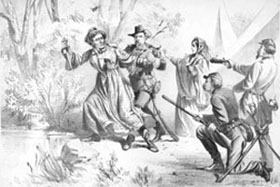Link To This Page — Contact Us —
The Capture of Jefferson Davis
May 10, 1865 in Irwinville, Georgia



|
In early May 1865 the Confederate States of America was greatly disorganized, largely because of the frenetic events of the previous month. Gen. Robert E. Lee had surrendered the Confederate armies at the Appomattox Courthouse in Virginia, and most Americans believed the Civil War was over. The assassination of U.S. president Abraham Lincoln in Washington, D.C., by John Wilkes Booth and other sympathizers with the Southern cause, cast suspicion over many in the Confederate government. Though still intact, the government was largely ineffective.
President Jefferson Davis still retained hopes for the future of the Confederacy. Privately, he harbored a desire to reinforce the armies and move the fighting to the western part of the Confederacy.
Publicly, he was forced to flee the Confederate capital in Richmond, Virginia, with a cadre of trusted advisors, which in effect became a government in exile. Upon departing Richmond, Davis and his retinue established a temporary center of government at Danville, Virginia. They soon moved farther south, however, because Virginia was heavily saturated with Union troops.
In the early part of May it was learned that Davis was fleeing for Texas to join Gen. E. Kirby Smith, there to try and re-establish the Confederacy.
Orders were at once issued by Gen. Wilson for his capture. The 1st Wisconsin Cavalry was ordered out on the north or east bank of the Ocmulgee River, and Col. Minty ordered out his old regiment, the 4th Muchigan cavalry, down the south or west side of the same river, with instructions to intercept and capture Mr. Davis and the party with him.
At Abbeyville, 70 miles south of Macon, it was learned that Davis' fleeing party had here crossed the ferry over the Ocmulgee and were moving southward toward Irwinsvuille, Ga., 30 miles below and 100 miles south of Macon. Lt. Col. B.D. Pritchard, in command of the 4th Michigan cavalry, marched the regiment rapidly down the river road, and after a 30 mile ride reached Irwinsville late in the night and learned that he had got in advance of the Davis party.
Davis was captured by the 4th Michigan Cavalry in the early morning of May 10, at Irwinsville in southern Georgia. With him were Mr. John H. Reagan of Texas, his postmaster general; Captain Moody of Mississippi, an old neighbor of the Davis family; Gov. Lubbock of Texas and Cols. Harrison and Johnson of his staff; Mrs. Davis and her four children, a brother and sister of Mrs. Davis, a white and one colored servant woman, a small force of cavalry, a few others and a small train of horses, mules, wagons and ambulances.
Surprised at the campsite, Davis attempted to escape by running into a swamp. In the confusion, he grabbed his wife's shawl to serve as a cloak. A soldier put a bead on him and was ready to shoot, while Davis, ever the warrior, believed the soldier would miss and he could still make his escape. But his wife, Varina, threw herself on Davis to save him from certain death.
As a final humiliation, the Union cavalrymen, seeing the shawl, claimed that he was wearing women's clothes as a disguise. There were a lot of people who honestly believed this rumor as being true.
Davis was transported to Fortress Monroe, Virginia, where he remained a prisoner for more than 2 years while the Federal government pondered his fate. His poor treatment and its subsequent exposure in the press helped strengthen the cause of Southern nationalism. Davis ended up in prison while the Federal government pondered his fate. The other members of the Confederate government became fugitives, some even escaping to foreign countries to avoid Davis's fate.

